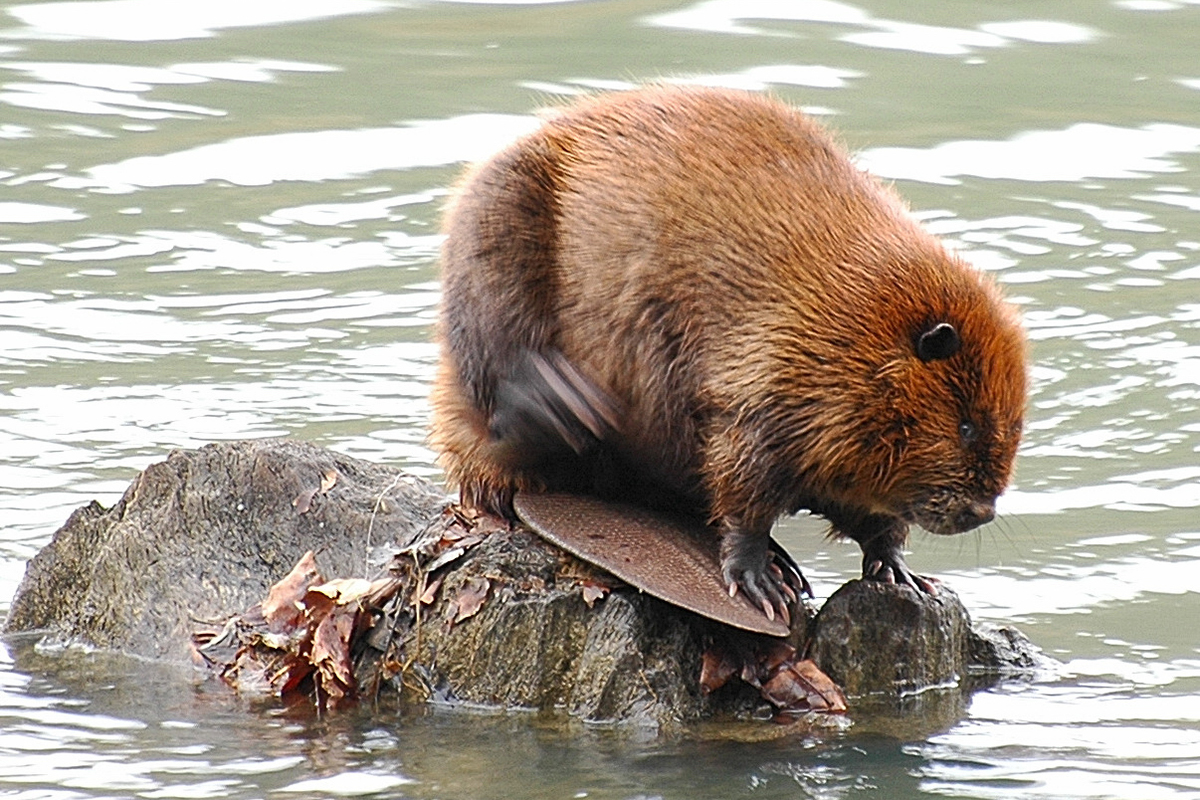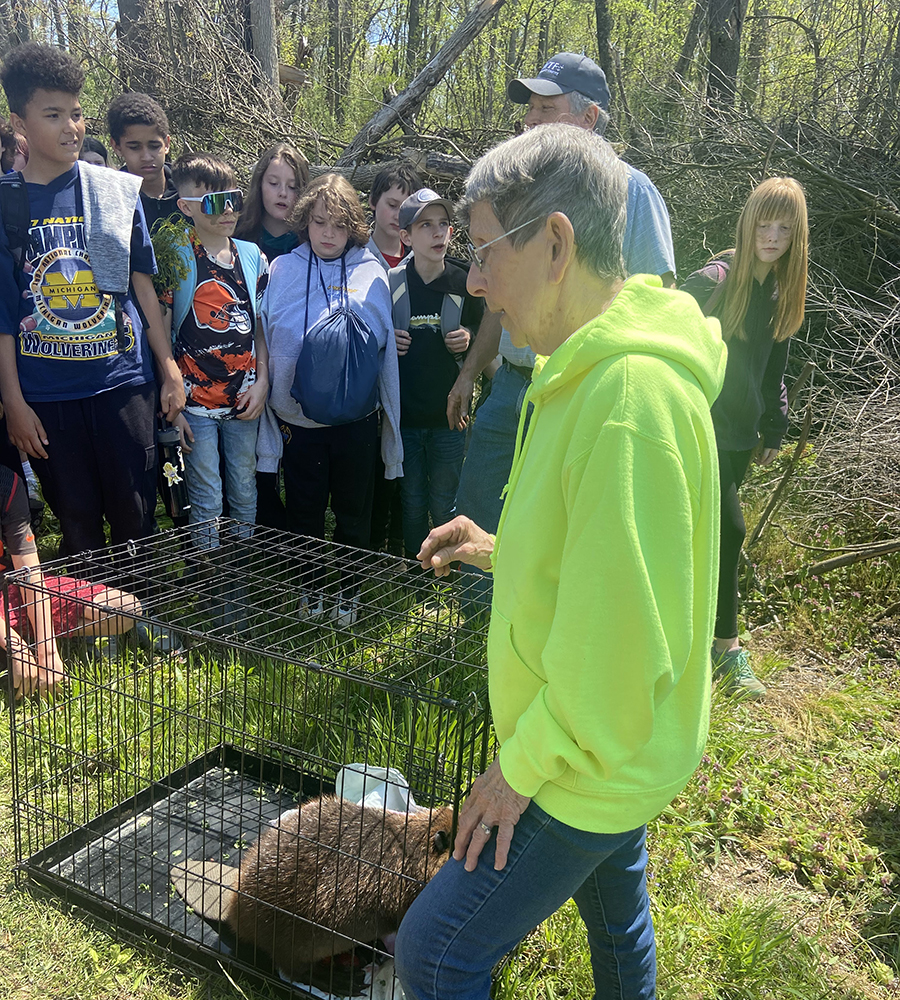
The seventh graders from Wooster’s Edgewood Middle School spent two days in May clearing debris, making brush piles and planting more than 1,000 trees at the Killbuck Marsh Wildlife Area. They were on an academic mission to find ways to help Killbuck recover from the derecho that roared through that area June 22 of last year.
They were also able to witness the release of a 1-year-old male beaver who had been cared for by Fran and Ron Kitchen, of Operation Orphan Wildlife Rehabilitation, Inc., located at their home in Akron.
The beaver was a bit intimidated by the crowd of young people, so he hung around the person he knew on shore. When the students began boarding the buses, he finally ventured into the marsh and began swimming around.
He climbed onto a tree stump that had been covered with dirt and mud by another beaver. “When he sniffed it, his tail slammed down with a very loud whack,” Fran said. “Then he jumped off and swam away.”
Keystone species

That was a good sign, she said. The tree stump had apparently been marked by another male beaver who left his scent in the dirt. The fact that the young beaver sounded the alarm with his tail shows he has developed survival instincts.
And that’s a good sign for Killbuck Marsh — or anywhere else that beavers can survive and thrive. Beavers are considered a keystone species; without them, wetland environments and populations of other species collapse.
“Beavers are the greatest wetland engineers we have,” said Dennis Solon, manager of the wildlife area. “They’re the only other species besides us that can change the environment.”
That ability to engineer wetlands is why Native Americans referred to them as “little people” and respected them as totem animals. It’s estimated that there were as many as 400 million beavers in North America when the first Europeans arrived.
Exploited and obliterated

Beavers were pretty much obliterated in Europe because their fur made the best felt and was coveted for the making of hats. Beaver hats were not only a fashion statement but a status symbol — including in the military — from 1550 to 1850 when they became passé in favor of silk hats.
When it was discovered that beavers were plentiful in the New World, they became the No. 1 resource to be exploited, ahead of gold, timber or anything else. Beaver pelts became currency, and the Hudson Bay Company and cities like Chicago were formed because of the fur trade. Some historians say it was actually the quest for pelts that led to Europeans’ westward exploration and settlement.
In the meantime, not only beaver but human lives were lost, especially in this area. According to Ohio History Central, a confederation of Iroquois tribes led the fur trade with their English and Dutch allies.
By the mid-1600s they had depleted beaver populations around the St. Lawrence River and moved their operation west to Ohio Country. The latter included all of what is now Ohio plus eastern Indiana, western Pennsylvania and northwestern West Virginia.
There, the confederation fought Algonquian-speaking tribes and their French allies in what were called the Beaver Wars. Despite a treaty in 1701, the bloody battles continued for control of land that yielded not only beaver pelts but deer hides for the fur trade.
By 1830, beavers had disappeared from Ohio, as they had from nearly all of the Lower 48 states. It was more than a century later, in 1936, when beavers were again spotted in Ohio, in Ashtabula County.
Protected
Since America’s land had been developed — including for agriculture — in the beaver’s absence, the country’s largest rodents weren’t always welcome when they moved back in. But limits were put on beaver trapping in 1961, and beavers are now protected in many places, like the nearly 6,000 acres of Killbuck Marsh.
When Solon began working there in 1980, beavers were just starting to move in. Since the Division of Wildlife bought the property, the beavers were now protected. And they wouldn’t be labeled a nuisance for doing what they did: Building dams that sometimes flooded as many as 30 acres at a time.
“For them it was like the Garden of Eden,” he said.
Beavers build dams to create safe places for their lodges, as well as plentiful food sources. Because there were already some deep marshes along Killbuck Creek, they only had to build low dams to flood large areas. Pretty soon there was almost no area of the marshes that hadn’t been influenced by beavers, Solon said.
In the process, the beavers made a variety of habitats for other species. Cutting trees creates niche habitats for species ranging from honeybees to foraging animals. It opens up the forest canopy, allowing plants, grasses and saplings to grow. It also soaks their ponds with sunlight, making water plants, invertebrates and insects multiply.
Thankfully, the beavers’ lowland habitat was not badly damaged by the derecho. That event, which Solon calls “tragic,” knocked down the trees in the 2.000-acre upland forest, some of which were 100 or 150 years old. The destruction was so complete that neither humans nor animals could get through the debris, which is still being cleared a year later.
100-year cycle
But there is something called the 100-year cycle that has affected Killbuck’s beaver populations. Although they also eat leaves, water lilies and other plants, beavers mainly feed on the cambium of trees, the layer between the bark and the trunk that creates new growth. When beavers flood an area, the trees eventually die and the beavers lose their most important food source.
Solon said many of Killbuck’s beavers have moved on, so he and his coworkers were happy to receive the one the Kitchens rehabilitated. As a baby, the beaver was apparently washed out by floodwaters in the Springfield Lake area. The people who found him couldn’t find the lodge or his parents.
Orphans

The Kitchens get between 800 and 1,000 orphaned babies a year, including groundhogs, chipmunks, rabbits and possums. Right now they’re overwhelmed with 60-some possums whose mothers were killed on the road or by predators.
They get an orphaned beaver — only one, no siblings — perhaps once a year. Beavers, who mate for life, have strong family bonds, Fran Kitchen said. They stay in the lodge and help care for younger siblings till the age of two, when Dad finally kicks them out. But this male (the Kitchens don’t name animals that will be released into the wild) was ready to venture out on his own at one year.
“We make sure the beavers have developed survival skills before releasing them,” Kitchen said. “This one had the skills at a year old, but for others we wait till they’re two.”
Baby beavers are fed formula but don’t nurse as long as other species. Then the Kitchens must find appropriate food. Luckily, their neighbors have cottonwood, hickory and crabapple trees, which beavers love.
The young beaver was housed in an eight-food-square cage that contained everything needed to build a lodge: straw, pea gravel, branches and dirt. Beavers can carry dirt in their mouths and use it to weatherize the top of the lodge.
He also had a horse trough for swimming. Since beavers will only defecate in water, the water in the trough had to be changed at least once a day, maybe twice. The Kitchens also took the little guy swimming in the lake.
At 78, Fran Kitchen has been helping orphaned wildlife for 60 years and is certified in education as well as rehabilitation. During the beaver’s release at Killbuck, she spoke to the seventh graders about the marvels of the species.
Busy
The saying “busy as a beaver” is no joke, she said. A single beaver can build a lodge in 24 hours or less. They can chew through a tree that is three inches in diameter in about 10 minutes.
Though the Eurasian beaver can be bigger, the American beaver can grow to nearly a yard long and weigh upwards of 60 pounds. Their tails “are solid muscle” and serve as rudders when swimming, props when sitting on land, and a warning signal when slapped on the water, Kitchen said.
They have an extra set of eyelids that are clear and serve as goggles when they swim. Their lips can close behind their huge front teeth so they don’t drown while swimming with branches or food.
The four big incisors are orange-colored because of a protective enamel coating that is rich in iron. Those teeth keep growing throughout the beavers’ lives, so they have to keep chewing to trim them down.
Beavers use their front paws like hands, especially for digging. The back paws are webbed and each has a double claw. Beavers pull hair through the claw to spread oils and keep their fur waterproof.
Environment changers
The wetlands that beavers create help turtles, salamanders, frogs and other aquatic species and make great fish nurseries, away from the fast-running water. Waterfowl sometimes walk where fish are spawning, get eggs on their feet and carry them to new sites, she said.
Even when the beavers move on, the environments they’ve engineered continue to benefit other species. When dams break, the sediment creates grassy meadows. Other species are known to use abandoned beaver lodges, including river otters.
Kitchen said Springfield Lake is busy with boats and people and would not have been an ideal place to release the rehabbed beaver. She and her husband were happy the Killbuck management accepted the new resident.
“Dennis said he’d welcome any beavers that we have in the future,” she said. “That’s nice to know.”









